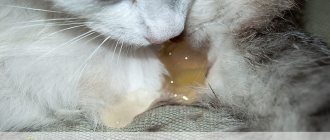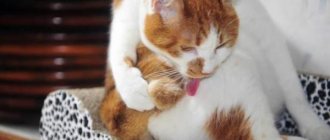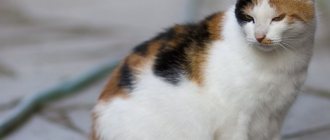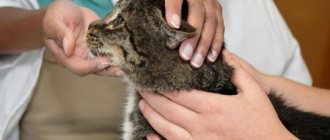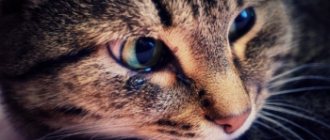17852Administration
Often, discharge from a cat on the outer labia is not considered normal and signals a problem with the animal’s health. Of course, you shouldn’t immediately panic and imagine a serious illness, because in some cases, discharge from the loop does not pose any danger.
But it won’t hurt to show your pet to a good veterinarian, since self-diagnosis is ineffective and is fraught with complications and consequences. Discharges can be very diverse :
- purulent;
- blood;
- watery;
- transparent;
- cloudy;
- white;
- gray;
- brown.
What kind of discharge does a cat have?
The first group of discharge is associated with the cat’s pregnancy and impending birth. If the cat is pregnant, then the presence of ichor is normal. Also, discharge appears when a cat comes into heat. Liquid flows from under the tail; it is a white or brown discharge. They will be accompanied by changes in behavior: meowing loudly, arching his back and taking a position for intercourse. The animal shows strong affection towards its owners. They have a translucent consistency, odorless and colorless.
Uterine infections in cats
In appearance, the discharge may have other signs:
- Color;
- Consistency;
- Presence and absence of odor;
- Abundance of discharge;
It is by these signs that the owner and veterinarian recognize the true cause and nature of the discharge, and also prescribe treatment. The frequency of discharge and its quantity are of great importance.
Note! Some mucus and pus may come out of the eyes as tears.
A cat's eyes are festering - how to treat it?
White discharge from the eyes, as well as watery and clear discharge, usually indicates an allergic reaction. Suitable eye drops, rinsing with solutions and using ointments will help you overcome it. It is imperative to determine the cause of the allergy, because without eliminating the original source of the disease, there is no point in dealing with the symptoms. If you notice bloody discharge, then this may indicate the presence of an infection in the pet’s body, or a violation of the patency of the tear ducts. In both cases, only veterinarian advice and a thorough examination will help. Home treatment without prior consultation with a specialist is highly not recommended.
Black discharge from the eyes occurs with infections, chlamydia and herpesvirus. Sometimes they occur due to ordinary injuries and have a shade close to brown. These discharges themselves are extremely dangerous, because apart from them there may be no symptoms. In any case, you need to visit a specialist for an examination and a course of treatment. Most often, antibacterial eye drops, solutions of chamomile infusion or strong tea are used. Rinsing with warm water will also work. Black discharge is removed with saline solution.
Since there are many reasons for the appearance of discharge from the eyes in cats, it is better not to do home treatment without visiting a doctor.
Trust the professionals and give your pet a long and happy life. An experienced veterinarian will not only determine the source of the disease and prescribe an appropriate course of treatment, but will also share with you valuable recommendations to prevent similar problems in the future. Your cat will certainly appreciate such a reverent attitude and will be grateful for the attention, care and kindness. Addresses of clinics Make an appointment with a doctor Prices
Physiological reasons
Physiological are considered reasons that cause discharge due to the characteristics of the body. Before giving birth, the female will have a plug, which is also a hard clot of mucus that comes out before giving birth. It does not bode well: it is necessary to “remove” everything unnecessary from the surface of the labia and prevent the occurrence of infections as a result of the introduction of harmful bacteria during childbirth.
Discharge from a pregnant cat: bloody, yellow
After your cat gives birth, she may continue to have mucus coming from her vaginal opening and anus for some time. Color – reddish or dark brown interspersed with greenish color. The norm is 3 weeks after birth. Due to the fact that during childbirth the discharge is red (the cat has bloody discharge), after the birth of the kittens the mucus will also have a reddish tint, which will gradually turn into a brown tint and disappear.
Reference! True, during pregnancy, yellow mucus sometimes comes out - amniotic fluid.
But not everything is as simple as it seems. There are much more dangerous secretions that indicate the presence of health problems. If they are not related to pregnancy, then they are not difficult to recognize. The next step is to determine the type, cause and prescribe the correct treatment.
Dangerous diseases arise as a result of infections that enter the body through the external environment, contact with other animals and sexual intercourse.
What is considered a physiological norm?
It is completely natural for a cat to have discharge during heat or estrus. The color of the discharge during this period is transparent, and the consistency is uniform without an unpleasant odor. The heat does not stop for several days, and the cat arches her back, exposes her hindquarters, and shows excessive playfulness and affection.
© shutterstock
Pregnancy and childbirth
Discharge during pregnancy may appear in a cat up to the third week. This is due to the fact that a mucus plug forms in the cervix, the excess of which flows out . This is usually clear or stringy mucus that is difficult to notice because it comes out along with urine. Until the 6th week, yellowish discharge is very rarely observed in small quantities - excess amniotic fluid.
And only a day or two before birth does the mucous plug come off (at 9 weeks). This is a small clot of yellow or greenish tint.
During contractions and pushing in a cat, the presence of brown and bloody discharge from the uterus is normal. For some time after childbirth, liquid greenish discharge appears, gradually becoming lighter, and then completely disappearing.
Scarlet blood at any stage of a cat’s pregnancy is always a sign of pathology and can be a signal of uterine rupture. The reason for the release of brown clots is placental abruption or fetal death . Green ones with an unpleasant odor indicate a bacterial infection, most likely due to the death of the kitten and the beginning of the decomposition process.
Dangerous diseases
The cat has bleeding on the second day after giving birth
Some brown, pink, clear and white discharge from a cat indicates dangerous diseases in your beloved pet. If she is not helped in time, the disease will progress, and ultimately some ailments lead to death, infertility and many other complications. Most often, veterinarians identify 7 diseases that affect animals. Some diseases occur through the entry of bacteria into the urethra and urethra.
Pyometra
Most often, this disease appears in older cats. When 2-3 months pass after estrus and the cat has not been fertilized, bacteria begin to develop in the uterine area, which can enter the body long before the onset of estrus. The fact is that without caring for the sperm and the development of the fetus, cysts form. As a rule, the main symptom of bacteria in the body is strong discharge, which can appear both during and after estrus. You can avoid this by sterilizing your cat on time.
The disease can be provoked by deterioration of hygiene standards during estrus, childbirth or operations. Risk factors: low physical activity of the cat, susceptibility to disease, inflammation, uncontrolled mating and much more. Along with the discharge, the cat's belly is rounded (lack of pregnancy), severe thirst and frequent trips to the toilet, bad behavior due to poor health, disheveled fur, and so on.
As the disease progresses, loss of appetite, vomiting, and diarrhea appear. Discharge with this disease is brown or white-brown in color.
Uterine trauma
Inflammation and trauma to the uterus occur as a result of various diseases, as well as birth injuries. The disease can progress and be accompanied by discharge and pain. This disease is also fatal. The more the disease progresses, the larger and more abundant the discharge will be. They cannot be left unattended, because they will lead to the imminent death of the pet.
Licking
The cat will constantly lick the genital opening; when the disease reaches the last stage, the animal will no longer have time to constantly lick the pus. Purulent discharge will be very noticeable on the floor where the pet sits, on the back of the fur. As with the previous illness, there will be severe thirst and frequent trips to the toilet, but the cat will practically stop eating. The volume of the abdomen will increase at high speed and in a few hours can reach such a size that it will look extremely unnatural. The cat will breathe very heavily, the owner will certainly pay attention to this.
Note! Frequent urination occurs because the slightest accumulation of urine in the bladder causes very noticeable pain. Bacteria can settle in the uterus 1-2 months before manifestation.
Vaginitis
The disease is characterized by swelling of the internal walls of the vagina and the first stage of the disease occurs calmly for the owner, since the cat will feel some discomfort, but it will not show it.
Symptoms in the second stage:
- Piteous meowing while going to the toilet;
- Attention from surrounding cats in the absence of heat at the moment;
- The pet will try to scratch the labia in different ways: on the carpet, furniture, or even begin to bite them;
- Grayish and white discharge and so on.
Endometritis
Another inflammatory disease of the uterus. Pathogenic microbes enter the uterus, multiply and cause inflammation. The first complication is poor health, problems with going to the toilet. The second complication is loss of reproductive ability. Deaths as a result of this disease are common. Occurs with low body resistance (weak immunity), postpartum complications, hormonal imbalance. It happens when animals take hormonal pills and they provoke various diseases.
Hydrometer
The uterine cavity accumulates fluid and mucous exudate. A less dangerous disease that shows few symptoms. The animal may not have sexual cycles (there will be no estrus and no subsequent pregnancy). As with any other disease, a diagnosis can only be made by a veterinarian, and discharge from a sterilized cat is almost the only noticeable symptom in the presence of such a disease. Treatment may sometimes require surgery.
animal surgery
Hematometer
It occurs when blood accumulates in the uterus and cannot be released due to a blockage in the cervical canal. The uterus ceases to function normally and may lose its functionality and reproductive capacity. The bloody discharge will not be profuse, but will cause discomfort. Bloody mucus (ichor) occurs due to poorly performed operations, spasms, miscarriages, fibroids and a number of other reasons.
The disease is rare; if left untreated, it can develop into pyometra, the treatment and consequences of which are more severe. The most severe symptoms appear as false contractions: the cat will take the appropriate position and meow pitifully. The cat may also have discharge.
Tumor processes
Cancerous tumors are often found in furry pets and are accompanied by copious discharge. Discharge due to the formation of a cancerous tumor will be accompanied by blood in the urine and feces, low appetite, ulcers, cough, and swelling.
Discharge appears as blood or pus from the genital area, as well as in those places on the body where wounds appear. It is difficult to treat tumors in animals, and the discharge may be no different from the discharge that occurs during estrus and other natural processes (if there is no blood, of course).
Reference! Some pets, especially those that go outside, develop wounds and scratches from fights with other animals. Sometimes an animal injures itself when it falls, and open wounds on the body must be treated and disinfected to prevent the entry of harmful bacteria. And there are often cases when purulent discharge appears from these same wounds on the body.
It is worth noting that not all tumors are related to oncology and the symptoms may differ, as well as the type and color of discharge during the disease. Sometimes they appear externally: on the front and hind legs, as well as on the body.
White discharge due to pyometra
One of the reasons for the production of white pus in a cat may be pyometra. This disease requires a very serious approach and intervention from specialists. The causes of this disease can be both hormonal imbalances in the pet and the consequences of endometritis.
If your cat's discharge is not properly treated, pyometra can appear very quickly.
The symptoms of this disease do not appear immediately. It's not just vaginal discharge. Signs such as fever, loss of appetite, thirst, and strange odors may appear. Closed pyometra is considered the most dangerous. In this case, the uterus is closed and prevents the cat from escaping white pus. Thus, the animal’s condition deteriorates very rapidly, leading to the fact that the pet can barely move.
Sometimes pyometra appears too late. There is no white watery discharge, and pus accumulates inside. Such processes can be fatal . The discharge of pus in a cat is not always noticeable, so you should carefully monitor your pet's condition. This is important, because only the owner can notice in time and prevent terrible consequences.
Diagnostics
To conduct a quality diagnosis, the owner must contact a professional veterinarian. Why is diagnosis by a doctor important:
- He will make an accurate diagnosis based on the possible causes of the disease. The owner can hardly identify the causes for sure, or does not search for the causes at all and buys medications in accordance with the symptoms. But one symptom can indicate several diseases at once.
- Depending on the age, character, weight, breed, causes and stage of the disease, the veterinarian prescribes treatment. Complex diseases often require not just some medications, diets and observation, but step-by-step treatment in different ways. It is not uncommon for treatment to require surgery.
Brown discharge from a cat's eyes
Independent actions may turn out to be wrong and cause more harm to the animal.
Note! Observation by a specialist is the most reliable way to cure an animal without complications or death in the shortest possible time.
Diagnosis is carried out through examinations, tests, ultrasound and the use of special medical equipment to examine internal organs. Continuous specialist supervision may be required.
Diagnosis of a pet
Diagnostics reveals more causes and problems of the body at more serious stages, but this does not mean that when a disease occurs, you need to wait until the pet becomes very ill. The more serious the stage, the longer, more difficult and more expensive the treatment, and the chances of fully restoring health become less.
Symptoms - how to understand that your cat is sick.
There are many unpleasant diseases that can affect your pet's vision. It is important to recognize them in time and seek qualified help, because the lack of treatment or untimely intervention by a specialist will aggravate the situation and even lead to complete or partial loss of the pet’s vision.
You should be seriously concerned about the condition of your furry friend if you notice the following symptoms:.
- Brown discharge from a cat's eyes, often mixed with pus, indicates the presence of a bacterial infection in the animal's body. Additional symptoms in this case may include lethargy and nasal discharge.
- Clear discharge, as well as abundant and thick discharge, warns you of a viral infection.
- Brown discharge most often appears when the tear ducts malfunction.
- If a cat has swollen eyes and waters with ordinary tears, without any admixture of pus, but in large quantities, she sneezes and itches, then most likely this is an allergic reaction. This disease is also heralded by redness of the eyelids and their swelling.
- Reddish discharge from the eyes can easily be confused with brown if the cat has a dark fur color.
- Watch his reaction to others - is the cat making contact or has he become unsociable?
- Has his appetite changed?
- Check for scratches and other mechanical damage near the eyes.
- Try to find out what color the discharge from the pet’s eyes is, and whether there is any admixture of pus in it.
Perhaps they are not so pronounced, and it is difficult for you to decide what exactly is bothering your pet. In this case, it is worth observing his behavior.
If all these symptoms are absent in your case, and the cat’s eyes are watering with ordinary transparent tears, then there is no reason to panic. There are a number of reasons why even a healthy animal can have watery eyes. This is an unsuitable diet, characteristics of the breed, an allergic reaction to certain components or substances.
How to help your pet
Loving owners always strive to help their pet. Whatever the methods, they must first of all be safe. If a cat is in heat, you need to encourage her natural urges and find a cat to breed. If you really don’t want your pet to have offspring, then you can “bring her back to her senses” with the help of special medications. For example, a special ointment that is applied to the nose every day. The animal will quickly return to its usual behavior and stop meowing loudly and chasing its owners.
Reference! If the discharge is not associated with estrus, then the best thing the owner can do is take the cat to the veterinarian, or call him at home (but if the disease is serious, then transportation to the clinic will be required).
The above diseases, after reading, should lead to the conclusion that the discharge indicates serious and dangerous diseases. Therefore, it is almost impossible to help your pet at home. Loss of appetite, baldness, deterioration in general condition and other dangerous symptoms cannot be “removed” on your own.
Why a cat's eyes are running - possible reasons.
An ordinary healthy cat always secretes a clear liquid secretion from the organs of vision, but it is almost unnoticeable. Those rare cases when a pet exhibits profuse lacrimation are also considered normal. This happens due to the negative influence of external factors such as smoke, dust, harsh lighting or caustic chemicals, and poor hygiene. As a rule, after the cat returns to its normal environment without external stimuli, the production of tears stops.
You should be concerned when a cat develops dark discharge from the eyes, as this is direct evidence of the presence of an infection in the animal’s body. If you notice cloudy, brown, white or red discharge from your pet, immediately seek help from a specialist and do not try to treat the animal yourself at home.
If there is a bacterial infection in the animal’s body, not a viral one, you will notice discharge from the eyes that differs from tears. They can also be white or yellowish in color and cause inflammation in the area.
There are a number of diseases that can cause disruption of the tear ducts in cats:
- This is the formation of tumors and neoplasms that compress the channels.
- Allergy to external irritants or food. This reason is one of the most common.
- Non-infectious inflammation of the lacrimal sac.
- Physical trauma to the eyes.
- A foreign object that has entered the lumen of the lacrimal canal.
- Stenosis of lacrimal openings.
- Narrowing of the tear ducts due to inflammatory processes in the body.
- Infectious conjunctivitis.
- Inflammation of the eyelids.
- Incorrect growth of eyelashes (trichiasis).
- Damage to the cornea.
- Disease of the eye vessels.
- Glaucoma.
- Breed predisposition. Some cat breeds, such as Persian or British, have a brachycephalic skull structure, which causes them to have a shortened tear duct and increased tear production.
- Helminthic infestations.
- Immunity problems. It is most common in kittens and older cats who often have colds, causing them to have excessive watery eyes.
Do not forget that whatever the cause of the disease, prolonged absence of proper treatment will worsen the situation. All this time the animal will experience discomfort. As a result, the cat will begin to scratch the sore eye, scratching it into wounds and increasing the area of infection with microbes.
Prevention is the key to health
To keep your pet healthy, you need to follow preventive measures. A few basic rules:
- Careful observation of changes in the animal’s appearance and behavior;
- Regular visits to the veterinary clinic for a professional examination of the animal;
- If the cat has already had illnesses, you need to use prophylactic agents in the form of tablets or drops;
- Limit your stay on the street in areas where there are many homeless animals;
- Examine your pet yourself and eliminate foods that may cause disease.
The period of pregnancy and after childbirth requires special attention: during these periods the body is more vulnerable to the emergence of dangerous diseases that are primarily associated with the uterus. For example, after giving birth, you can call a veterinarian to your cat’s home for an examination; in no case should you allow the cat to be in hygienically unsuitable places in the first hours and days after birth: the street, the basement, contaminated places in the house. The same rules must be followed during childbirth.
If a cat has brown discharge from under its tail, it may be noticeable in the places where it sits. In some diseases, the discharge is very light and the animal will constantly lick it off. In this case, you need to pay attention to the fact that the cat will often begin to lick its perineum. In the second part of the disease or in severe stages, the mucus does not have time to be “cleaned up” by the cat itself and remains on the floor, furniture or rug. If your cat is leaking white fluid from under its tail, you should immediately consult a doctor.
Bloody discharge after pregnancy
If your cat has bloody discharge after pregnancy, this may indicate tissue rupture.
This cannot be done without the intervention of a doctor, who will independently determine measures to eliminate the problem.
Often, specialists use hemostatic agents. Well, if the cat has lost a lot of blood, surgery may even be required.
Purulent-bloody discharge with a greenish tint may indicate inflammation of the cat’s genital organs. There are some prerequisites here:
- violation of sanitary standards;
- infection;
- internal diseases.
By the way, the cause may also be a fetus stuck in the cat’s womb. A process of decay occurs, causing the mother to become intoxicated. Of course, this could also be ordinary remnants of the placenta, the abundant release of which is not so terrible. Simple antibiotics will help here. However, in more severe cases, surgery will be required.
If you see drops of blood along with milk that come out as discharge from the genitals, then you can judge about inflammation of the mucous membrane.
A cat's body, which is weak after pregnancy, may not be able to cope with such a complication. However, with a calmer initial stage, the animal does not even need to be separated from its offspring.
© shutterstock

